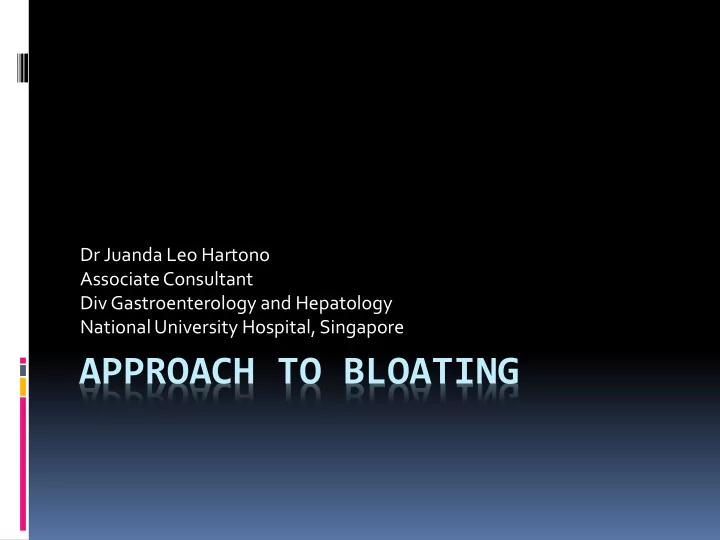

Dr Juanda Leo Hartono Associate Consultant Div Gastroenterology and Hepatology National University Hospital, Singapore APPROACH TO BLOATING
Epidemiology Very common symptom in primary care (10- 30% in population based studies) Most are benign Majority present as part of other Functional GI Disorder, esp Functional Dyspepsia and IBS Bloating as the only symptom (Functional Bloating) is uncommon
Patient’s Possible Range of Symptoms Bloatedness Abdominal fullness Abdominal Tightness Distension Increased burping / belching Increase flatulence Bloating NOT THE SAME AS Distension
Before you label ‘Functional…’ make sure it is not physiological
Consider Possible Organic Etiology Foley et al. Gastroenterol & Hepatol 2014;10(9):561-71
Red Flag Features Age >50 years old Family history of GI malignancy in a first degree relative Unintended weight loss GI bleeding or iron deficiency anemia Dysphagia Worsening or change in character of symptoms despite usual measures
Basic Investigation FBC, LFT, Renal Panel ESR (especially in diarrhea) Ultrasound (HBS or pelvic depending on suspicion)
Dyspepsia Algorithm ASGE guideline 2015
Rome III Criteria : FD
Rome III Criteria : IBS
Rome III Criteria : Functional Bloating Only small proportion of patients will fall into this group
Putative Mechanism
Abdominal Wall displacement theory
Visceral Hypersensitivity ‘ What do you mean I am not being sensitive inw(n)ardly ? ‘
Non-medical therapy for Bloating Low FODMAP diet (50-75% response in RCT) Physical activity promote gas transit Biofeedback for Constipation with pelvic floor dysfunction Abdominal wall displacement correction (preliminary)
What is FODMAP? Fermentable Oligosaccharides Inulin & fructo-oligosaccharides (eg: wheat, onion) Galacto-oligosacharrides (eg: legumes: beans, peas) Disaccharides (eg lactose in dairy products) Monosaccharides Free fructose (excess fructose relative to glucose) And Polyols ( sorbitols, mannitols) : artificial sweeteners
Management : low FODMAP diet
RCTs of Medications used to relieve bloating Ionivo P et al. World J Gastroenterol 2014;20(39):14407-19
Algorithm Foley et al. Gastroenterol & Hepatol 2014;10(9):561-71
Algorithm Foley et al. Gastroenterol & Hepatol 2014;10(9):561-71
THANK YOU
Recommend
More recommend